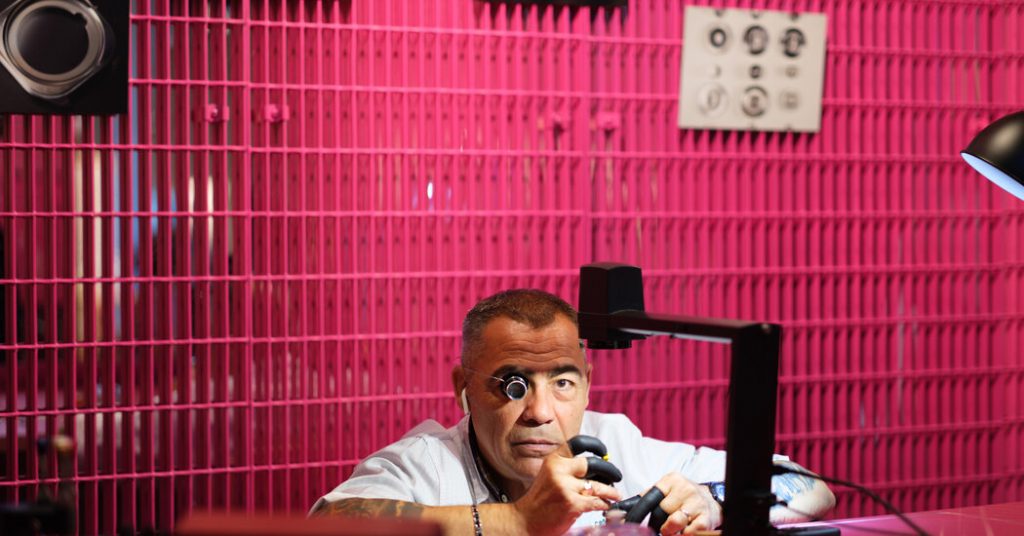
An Exhibition by and About Hermès Showcases Process and Precision
The latest incarnation of “Hermès in the Making,” a roving exhibition that’s already stopped in Copenhagen and Turin, Italy, has landed at the Somerset Collection shopping center in Troy, Michigan, just outside of Detroit. If this seems like a slightly surprising place for the French luxury brand to have set up shop, the show serves as a reminder, even if it’s an unspoken one, that both Hermès and the area have long and rich histories of craftsmanship, the latter as the longtime seat of the American auto industry and a locus of midcentury modern design, and the former as a producer of everything from saddles to scarves to porcelain.
It endeavors to give a behind-the-scenes look at how Hermès’s team of artisans create and maintain some of these enduring objects and, in doing so, offers a window into what makes the fashion house stand out. As Guillaume de Seynes, an executive vice president at Hermès who oversees manufacturing and equity investments, says, it’s Hermès’s relationship to its makers — and their relationship to their respective crafts — that gives the maison its human touch, as well as integrity and a certain soulfulness.
At the same time, he stresses that craftsmanship isn’t some stuffy, stagnant thing but, rather, always evolving. “It’s about learning,” he says. “As an artisan you’re constantly discovering, being confronted with new forms of creativity and developing know-how.” That spirit of openness and respect for technique is on display at 10 stations, at which 11 artisans, mostly flown in from Paris, who work for the house’s different métiers, demonstrate skills related to, among other things, silk printing, saddle making and leather repair.
In one corner, you might find an artisan hand-painting cyan blue onto white ceramic tableware, creating scenes of wildcats and tropical flora. Elsewhere, you can observe a silk engraver who uses her computer’s touch screen to color and fill in the design that will then be printed onto the lustrous fabric. Or perhaps you’ll catch a whiff of the deep, earthy scent of Hermès’s Volynka line of mahogany brown leather bags. Last week saw an interactive workshop on the exacting process of leather stitching; guests got to take the fruits of their labors, stitched leather bookmarks, home with them. As part of the project, there have also been two panels, held at Detroit’s College for Creative Studies and moderated by Rebecca van Bergen of the nonprofit artisans’ guild Nest, on the concepts of repair and regeneration, with Aki Choklat, the chair of fashion design at the college, and the fashion designer (and Detroit native) Tracy Reese acting as panelists.
Unsurprisingly, the exhibition space itself was also thoughtfully conceived. Curved strips of light wood connect one station to the next and evoke the look of a long deconstructed workbench. Each station also features whimsical tableaus — glass bottles holding vibrant powdered pigments for textile dyes, framed scarves hung against a canary yellow backdrop.
The show is located just behind an Hermès store, the area’s first, which opened last June. “Although we have only been here for about a year now, we have already noticed a tremendous community spirit,” says de Seynes, who points out certain parallels and connections. “Hermès was founded in 1837 in Paris as a harness maker, focusing on the main means of transportation at the time: the horse. In the early 20th century, with the invention of the automobile, it had to transform itself completely, proposing new objects like bags to its customers.” He continues: “Emile Hermès, my great-grandfather, discovered the reality of the automobile industry by visiting the United States in 1917, and understood the necessity of adapting.”
Still, while not many people travel by horse these days, there’s something particularly transfixing about the saddle station. Watching the saddler at work, you might find that his enthusiasm becomes infectious. A nearby chair, part of the brand’s Petit H collection, is made from an unused saddle tree and leather pieces. “I hope that visitors leave with a profound understanding of the passion and pride that Hermès artisans embody in their careers as craftspeople,” de Seynes says. “Being able to talk with the artisans allows for visitors’ questions to be answered directly by the source — which is the best way to learn.” “Hermès in the Making” is on view through June 15.